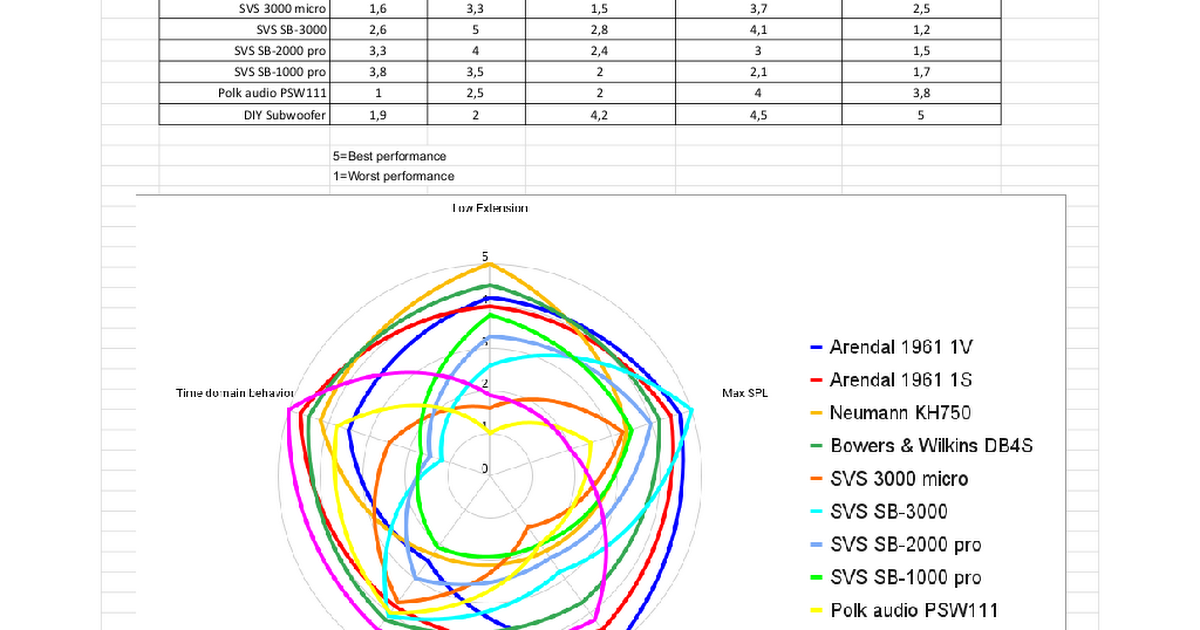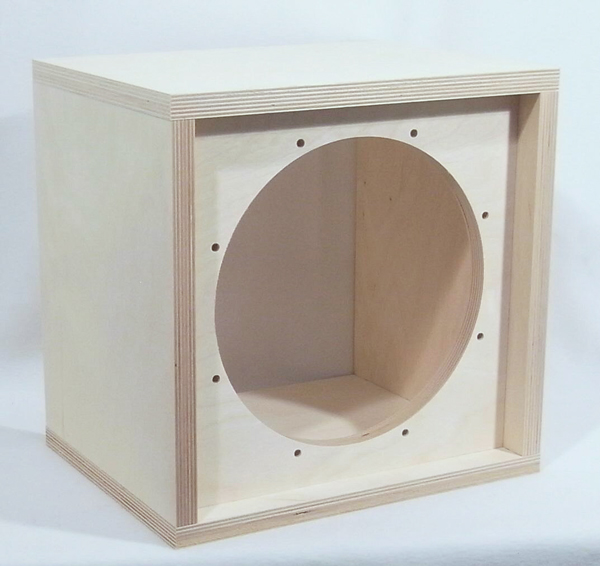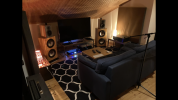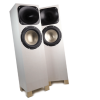true, and that "unity" horn on your picture looks epicthanks so much for this.
This post has me really mourning the loss of data-bass.com
FWIW in my professional and enthusiast experience, DIY for subwoofers is a no brainer. So many amazing plans out there, and you can easily beat the Neumann performance for 1/3rd the cost and an afternoon of wood cutting and assembly.
-
WANTED: Happy members who like to discuss audio and other topics related to our interest. Desire to learn and share knowledge of science required. There are many reviews of audio hardware and expert members to help answer your questions. Click here to have your audio equipment measured for free!
You are using an out of date browser. It may not display this or other websites correctly.
You should upgrade or use an alternative browser.
You should upgrade or use an alternative browser.
I measured 10 subwoofers.
- Thread starter Nuyes
- Start date
Out of fear to burn my scrolling wheel and tearing my finger tendons, a lazy request: Is there al TL;DR? A clear perfomance winner and a price/value winner? Which one is the loser?
Depends what you want, then the winner should be made clear by the graph in #135Out of fear to burn my scrolling wheel and tearing my finger tendons, a lazy request: Is there al TL;DR? A clear perfomance winner and a price/value winner? Which one is the loser?
I like how the Arendal 1961 1S performs.
True, the only site we have left is Audioholics...This post has me really mourning the loss of data-bass.com
True, especially if you want multiple big subwoofers providing a huge amount of deep bass output.FWIW in my professional and enthusiast experience, DIY for subwoofers is a no brainer. So many amazing plans out there, and you can easily beat the Neumann performance for 1/3rd the cost and an afternoon of wood cutting and assembly.
However, this case is a great example to show that this is not always wuite true. The driver @Nuyes used, costs around 400 bucks plus the crown amp that's another 400 bucks (ok he's probably powering both of them with one amp so lets say 200 per sub for amplification) and depending on the use case some additional DSP.
Idk how much the MDF would cost... maybe 50 bucks? And I'd say another 20-30 bucks for paint, screws, the Neutrix connector etc...
So we are already almost at about 700 bucks and that's without accounting for your time. People often forget about that part, sure if you really love building things than you'd might say the time effort you have to put in doesn't matter but I guess a lot of people would rather have a finished built sub than having to build it themselves.
The other thing people often forget is that you have to have some sort of workshop equipped with the proper tools - not everybody has that.
So at that price you could pretty much buy an Arendal 1S for 900.- which would look way nicer, have more features, a warranty and better value if you ever want to sell it again. It even has better performance (in terms of output and depth) than the DIY sub with the correct limiters already in place so you don't have to worry about blowing your sub if you are not careful with playing heavy bass for hometheater.
Schollaudio
Active Member
- Joined
- Jun 24, 2021
- Messages
- 170
- Likes
- 90
The L26RO4Y looks great!! A DIYer willing to spend the extra money will be rewarded with some of the lowest distortion bass a small box can bring.
I know this is personal preference and very niche, but I would love if that were true for the 3000 micro. My setup is in the living room close to both bedrooms. If low level morning listening by my son didn’t have the 25-35hz region, but did at movie night levels that would be a potentially happy accident. Not good for a majority of users here.That's an interesting question. The top chart is a tool calibration at 80 dB SPL @ 2m and the second is a frequency response at 85 dB SPL at 100 Hz @ 2m. I wonder if adding that +5 dB SPL caused the speaker to use a different loudness profile? I didn't think the 3000 micro had dynamic frequency response.
I’ll probably reach out to SVS for some feedback on that graph.
PS: I just bought a used 3000 micro but haven’t set it up. Hopefully this afternoon. Between this, @sweetchaos Google Sheet, and hearing about the Kali KW-62 I wish I went for the KW-62. I’m following a nearfield subwoofer suggestion Mr. Toole posts somewhere on the forum. I need something small to go right behind the couch, and wanted dual opposing woofers to minimize vibration as it’ll sit on a low shelf.
IndeedThe L26RO4Y looks great!! A DIYer willing to spend the extra money will be rewarded with some of the lowest distortion bass a small box can bring.
TurtlePaul
Addicted to Fun and Learning
I like this data, but wish more bass reflex subs were included.The L26RO4Y looks great!! A DIYer willing to spend the extra money will be rewarded with some of the lowest distortion bass a small box can bring.
Imagine the L26RO4Y if it was paired with the SL26R passive radiator in a 13"x15"x17" box. The distortion would be very very low and deep bass without need for EQ.
Color me not impressed at his test run of the DIY with a 40 hz -6 dB and 30 hz -10 dB. Of course distortion is low. The box is too small with no reflex.
Last edited:
Hello All,
Looking at the tables I started to wonder if there are curves or figures that report the non-linear distortions of the spl vs input voltage response.
If you look at the 50 hz column of results (where most devices perform best) , we usually observe that 1 dB change in the input voltage gives 1 dB change in the spl, typically up to the max spl, after which the spl just does not increase anymore.
However, at other frequencies you sometimes have less than one dB spl change for one dB voltage change.
For example, the B&W can output 103 dB max at 32 Hz but, starting from 98 dB, each 1 dB change of the input only gives about 0.6 dB spl change, while the spl change is adequately 1 dB at 50 Hz.
This reflects a non-linear response of the SW which generates distortion even though the thd is still ok at those levels.
It just means that the frequency response's shape changes with the level.
If you compare to the Neumann you'll see that the latter is almost perfectly linear up to its max spl for each tested frequency.
This is easily observed in the max spl vs input voltage curves : for example up to 96 dB spl all the curves are exactly the same down to 25 Hz. This means that the frequency response must be perfectly flat and that 1 dB input change gives 1 dB output change whatever the frequency starting from 25 Hz.
In other words the subwoofer is linear at 96 dB spl down to 25 Hz.
At 101 dB the linearity is good only down to 32 Hz.
This excellent behaviour is visible in the curves that are almost exactly horizontal once they leave the 'main trace' of the frequencies still offering a linear response.
This is all certainly thanks to the dsp. In addition to parametric filters it almost certainly implements non-linear transfer functions : the gain correction depends on the input level.
Are there any figures quantizing those non-linearities ?
As I had the chance to test old Pioneer and Yamaha AVRs as well as a slightly newer Denon Avr x3600h I know that their room correction systems perform all their tests at a single output level, therefore they certainly can NOT account for those non linearities.
Are the competing systems (Dirac, etc...) testing at différent levels ?
Looking at the tables I started to wonder if there are curves or figures that report the non-linear distortions of the spl vs input voltage response.
If you look at the 50 hz column of results (where most devices perform best) , we usually observe that 1 dB change in the input voltage gives 1 dB change in the spl, typically up to the max spl, after which the spl just does not increase anymore.
However, at other frequencies you sometimes have less than one dB spl change for one dB voltage change.
For example, the B&W can output 103 dB max at 32 Hz but, starting from 98 dB, each 1 dB change of the input only gives about 0.6 dB spl change, while the spl change is adequately 1 dB at 50 Hz.
This reflects a non-linear response of the SW which generates distortion even though the thd is still ok at those levels.
It just means that the frequency response's shape changes with the level.
If you compare to the Neumann you'll see that the latter is almost perfectly linear up to its max spl for each tested frequency.
This is easily observed in the max spl vs input voltage curves : for example up to 96 dB spl all the curves are exactly the same down to 25 Hz. This means that the frequency response must be perfectly flat and that 1 dB input change gives 1 dB output change whatever the frequency starting from 25 Hz.
In other words the subwoofer is linear at 96 dB spl down to 25 Hz.
At 101 dB the linearity is good only down to 32 Hz.
This excellent behaviour is visible in the curves that are almost exactly horizontal once they leave the 'main trace' of the frequencies still offering a linear response.
This is all certainly thanks to the dsp. In addition to parametric filters it almost certainly implements non-linear transfer functions : the gain correction depends on the input level.
Are there any figures quantizing those non-linearities ?
As I had the chance to test old Pioneer and Yamaha AVRs as well as a slightly newer Denon Avr x3600h I know that their room correction systems perform all their tests at a single output level, therefore they certainly can NOT account for those non linearities.
Are the competing systems (Dirac, etc...) testing at différent levels ?
Sorry for being off topic, but BTW, out of curiosity i just tried a stereo sub setup. It is easier now than before, when the MA1 software supported only 1 sub.Thank you! Especially for the link! I think it is a major disadvantage in relation to a three way Speaker with „build in“ bass, if you are not able to put the crossover frequency to - let’s say- 250 Hz and if you are not able to hear stereo in the range betweenn 25 Hz and 250 Hz. The biggest advantage of a combination with small boxes and subwoofer is that you are able to put the woofer one meter or so closer to the listener. So you have good phase linearity, which is nearly impossible with passive 3-way or 4-way speakers! But I want Stereo Subs of course!
I started with my dual mono sub setup. For calibration, both subs receive a stereo signal, but the bass is summed to mono by Neumann DSP. But i can then just sent left channel only to left sub+left main and right channel only to right sub+right main with my RME TotalMix software. Then, i altered my alignment, using the values posted by Neumann as a starting point and tuning them a bit after a REW measurement (see image). This is necessary, because otherwise the bass is too quiet because the DSP still "expects" a stereo signal.
I now have a stereo sub setup calibrated with MA1 (with fixed 80Hz crossover).
Don´t ask me if it sounds better. I don´t know. Maybe.
TurtlePaul
Addicted to Fun and Learning
However, at other frequencies you sometimes have less than one dB spl change for one dB voltage change.
For example, the B&W can output 103 dB max at 32 Hz but, starting from 98 dB, each 1 dB change of the input only gives about 0.6 dB spl change, while the spl change is adequately 1 dB at 50 Hz.
This reflects a non-linear response of the SW which generates distortion even though the thd is still ok at those levels.
I think that a lot of these subs have the opposite of what you are thinking. A lot of micro subs now will play as low as they dare, even down into the teens hz, but will reduce low frequency output as SPL increases. This way, they are only flat when playing at 75-80 dB. The dynamic DSP knows how much power the amp has and how much excursion the driver has and throttles back the bass accordingly at higher SPLs. DSP makes it so a tiny box can play to sub 20 hz or can play to 100+ dB, but physics dictates both can't happen at the same time.This is all certainly thanks to the dsp. In addition to parametric filters it almost certainly implements non-linear transfer functions : the gain correction depends on the input level.
For a studio monitor sub like he Neumann, the designers would much rather the sub go into protection or distortion rather than exhibiting a non-flat response.
Last edited:
This is great, especially the column chart. Would like one more column, Size, 1-5 (5=largest) volume= size? woofer dia.?Fantastic report, @Nuyes . Thank you!
What I was missing was a global overview, and since I did it for a friend who's looking for a subwoofer, I thought I'd share it with you:
View attachment 322162
5=best performance
1=worst performance
Difficult to establish a high level score when things are not comparable sometimes ; so I've filed the blanks using some of my experience on correlating measurements and subjective impressions.
Let me know if there are discrepancies with your observations, I can correct it. (some probably remain as it takes time to do this - hopefully small)
Here's the data if you want to comment/reuse:

ASR Subwoofer Comparison
Subwoofer Original thread: <a href="https://www.audiosciencereview.com/forum/index.php?threads/i-measured-10-subwoofers.49042/">https://www.audiosciencereview.com/forum/index.php?threads/i-measured-10-subwoofers.49042/</a> Low Extension,Max SPL,Harmonic distortion,Intermodulation distortion,Time...docs.google.com
Next, if time allows, it'd be nice to have a table summarising the technology used for each subwoofers (closed/ported, woofer size , volume, etc..)
Hellasärö
Member
- Joined
- Sep 9, 2022
- Messages
- 50
- Likes
- 93
Great and versatile driver. Can be crossed over up to 1.5khz. A DIY’er here in Finland made a 2-way speaker with the L26 and combined it with a compression driver and a horn. I myself have two custom made bass/sub pilars that double as stands.The L26RO4Y looks great!! A DIYer willing to spend the extra money will be rewarded with some of the lowest distortion bass a small box can bring.
Attachments
Last edited:
DanielT
Major Contributor
DIY Subwoofers are built with Plywood. It has characteristics more suitable for subwoofers. The material stiffness of Plywood vs MDF is higher. Less, perhaps no, internal bracing of the boxes is needed (depends on how big they are). Of course, no "fluff" in the boxes. Nothing that reduces sensitivity should be added.Idk how much the MDF would cost... maybe 50 bucks? And I'd say another 20-30 bucks for paint, screws, the Neutrix connector etc...
MDF for full range speakers.
totti1965
Active Member
Cool Implementation. Cool Workaround!Sorry for being off topic, but BTW, out of curiosity i just tried a stereo sub setup. It is easier now than before, when the MA1 software supported only 1 sub.
I started with my dual mono sub setup. For calibration, both subs receive a stereo signal, but the bass is summed to mono by Neumann DSP. But i can then just sent left channel only to left sub+left main and right channel only to right sub+right main with my RME TotalMix software. Then, i altered my alignment, using the values posted by Neumann as a starting point and tuning them a bit after a REW measurement (see image). This is necessary, because otherwise the bass is too quiet because the DSP still "expects" a stereo signal.
I now have a stereo sub setup calibrated with MA1 (with fixed 80Hz crossover).
View attachment 322245
Don´t ask me if it sounds better. I don´t know. Maybe.
TheHighContemplator
Active Member
Very nice work. Do you have the build documented somewhere I can read or watch?Great and versatile driver. Can be crossed over up to 1.5khz. A DIY’er here in Finland made a 2-way speaker with the L26 and combined it with a compression driver and a horn. I myself have two custom made bass/sub pilars that double as stands.
radix
Major Contributor
- Joined
- Aug 1, 2021
- Messages
- 1,417
- Likes
- 1,357
EDIT: I thought the sub was enclosed, but it is also open baffle like the other half of the speaker. So, no back on the enclosure.DIY Subwoofers are built with Plywood. It has characteristics more suitable for subwoofers. The material stiffness of Plywood vs MDF is higher. Less, perhaps no, internal bracing of the boxes is needed (depends on how big they are). Of course, no "fluff" in the boxes. Nothing that reduces sensitivity should be added.
MDF for full range speakers.
If someone in the US is looking for a DIY L26RO4Y with less "Y," you could try the kit from Madisound. It's a 13x13x10 flatpack enclosure for $64 and you can add the driver for another $400 ($470 for the whole thing with mounting hardware). You still need a DSP and amp.

Open Baffle Subwoofer Flat Pack (LXsub2)
Open Baffle Subwoofer Flat Pack for 10" Subwoofer (LXsub/LXmini+2) - EACHUsed as the +2 subwoofer option for the LXmini speaker kit, and cut for the Seas L26RO4Y. Order quantity 2 if building this design. A single, dual, or multi sub setup with these is a good choice for integration with other...
Last edited:
I am not thinking, I'm just reading the results.I think that a lot of these subs have the opposite of what you are thinking. A lot of micro subs now will play as low as they dare, even down into the teens hz, but will reduce low frequency output as SPL increases. This way, they are only flat when playing at 75-80 dB. The dynamic DSP knows how much power the amp has and how much excursion the driver has and throttles back the bass accordingly at higher SPLs. DSP makes it so a tiny box can play to sub 20 hz or can play to 100+ dB, but physics dictates both can't happen at the same time.
For a studio monitor sub like he Neumann, the designers would much rather the sub go into protection or distortion rather than exhibiting a non-flat response.
These non linearities are perfectly explicit in the tables :
Consider a signal made of two tones of equal amplitude at 40 and 50 Hz.
With 0.2V at the input of the B&W sub you get almost the same amplification at the 2 frequencies (0.5dB difference) , but at 0.5V the difference is much larger (almost 2dB).
B&W
0.2V => 98.68 dB@40 Hz / 99.17 dB@50 Hz (difference = 0,49 dB)
0.5V => 105.14 dB @40 Hz / 107.07 dB @50 Hz (difference = 1.93 dB)
So you see a non-harmonic distortion of almost 1.5 dB, but that's really a pity, because the subwoofer CAN cleanly output 107 dB @ 40 Hz, but this requires 1 V at the input.
With a clever processing the sub could have been transparent for these 2 tones up to 107 dB (or a little less) while in this case the difference exceeds 1 dB as soon as 104 dB.
I think this is called compression.
What I observe is that the Neumann optimizes its physical capabilities : the problem happens only when the device reaches its physical limits while in the B&W the problem appears progressively over a much larger input range.
The Neumann dsp seems to compensate the non linearities of the analog transduction while there is apparently nothing of that sort in the B&W.
My questions are whether any convenient figure or chart quantifies these problems.
I also wonder how important this is compared to the usual linear harmonic distortion.
1 or 2 dB may not be very important, especially at those low frequencies (?)
When Amir tests a speaker he publishes the distortion at multiple output levels.
It would be also very interesting to compare the frequency responses at those different levels.
We could normalize at, say, 1 kHz and draw the relative curves. A perfectly linear speaker would show exactly the same curves, even if not perfectly flat.
If the curves are not identical then a parametric EQ correction could be fine at a certain level and bad at other levels.
While I prefer baltic birch ply for my builds (both speakers and subs), many diy subs are mdf.DIY Subwoofers are built with Plywood. It has characteristics more suitable for subwoofers. The material stiffness of Plywood vs MDF is higher. Less, perhaps no, internal bracing of the boxes is needed (depends on how big they are). Of course, no "fluff" in the boxes. Nothing that reduces sensitivity should be added.
MDF for full range speakers.
TurtlePaul
Addicted to Fun and Learning
That is an open baffle kit, which may not be to everyone’s liking. Open baffle costs a lot of bass (from rear wave cancellation).If someone in the US is looking for a DIY L26RO4Y with less "Y," you could try the kit from Madisound. It's a 13x13x10 flatpack enclosure for $64 and you can add the driver for another $400 ($470 for the whole thing with mounting hardware). You still need a DSP and amp.
Similar threads
- Replies
- 68
- Views
- 8K
- Replies
- 134
- Views
- 40K
- Replies
- 96
- Views
- 14K
- Replies
- 11
- Views
- 1K
- Replies
- 4
- Views
- 897


